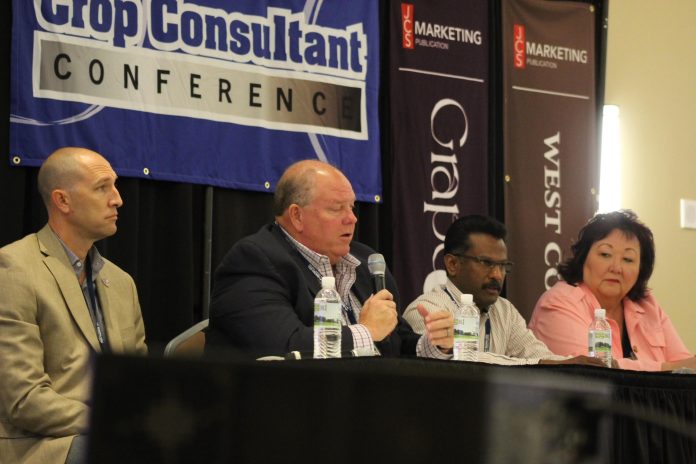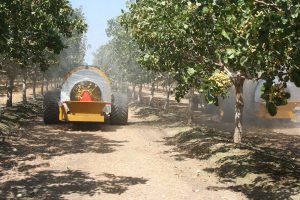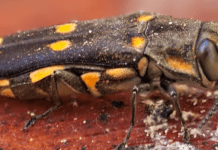
Nearly a year ago, the California Department of Pesticide Regulation (DPR) unveiled the Sustainable Pest Management Roadmap for California (SPM), a plan that aims to speed up the state’s transition into sustainable pest management and to eliminate high-risk pesticides by the year 2050. Now, as the California ag industry is left to contemplate a different looking future for pesticides in less than two decades, industry experts are coming together to help pesticide users fill in some of the blanks.
The 2023 Crop Consultant Conference, held in Visalia, Calif. in late September, gave attendees the chance to sit in on a panel discussion to address the future of pesticides in California once many of the familiar go-to’s are no longer an option under SPM. A press release published by the SPM workgroup in January laid out the bold plan, calling it “the way to a phase-out and replacement of the highest-risk pesticides to build a healthy and safe California.” Panelist Roger Isom, president of both Western Agricultural Processors Association (WAPA) and California Cotton Ginners and Growers Association, said SPM is just a fancy name for eliminating pesticides.
The plan also includes the implementation of a notification system to begin in 2024, which DPR says will provide the public with “advance, transparent and equitable access to information about pesticide applications.”
While the panelists at September’s meeting were resigned to accept the upcoming changes, they collectively agreed that they were rigid and would take extensive time, money and research to develop strategies for the ag industry to find its footing under the plan.
Renee Pinel, president and CEO of Western Plant Health Association, served as the panel moderator. Western Plant Health Association, a trade association that represents Pesticide fertilizer manufacturers, ag biotechnology providers, and agricultural retailers in California, Arizona and Hawaii, regularly works with DPR on pesticide issues.
Isom said sustainability already exists for California growers who are working to minimize input costs as part of traditional pest management programs.
“There isn’t a grower or PCA or CCA in this room who hasn’t tried to reduce pesticide use, minimize pesticide use and find a better way to do it. It’s what we’ve been doing for years,” Isom said. “We’ve called it integrated pest management.”
Isom referred to the elimination of Chlorpyriphos as an example of what the pesticide roadmap could lead to: An elimination of products without providing any alternatives. He said the goal of SPM is to reduce priority pesticides, which he said more or less consists of every product the ag industry uses.
WAPA represents 180 tree nut hullers and processors of walnuts, almonds, pecans and pistachios throughout California, and both associations Isom represents work on regulatory and legislative issues as well as compliance and research. He said that they have always been about reducing or minimizing pesticides.
“Every dollar we spend is a dollar less we make,” Isom said. “If we don’t have to spray for anything, we won’t. That’s what we do. But that’s not what this is about.”
Panelist Daniel Hartwig, director of sustainability for Woolf Farming, said that sustaining the business means keeping it viable to succeed for generations to come.
“If we are spending thousands of dollars an acre on pesticides, that’s not very sustainable, and if we have to spend thousands of dollars to convert to SPM, that’s also not very sustainable,” he said.
Woolf Farming is a vertically integrated company that grows almonds and pistachios among numerous other crops and deals with energy, regulatory, sustainability and water issues. Hartwig said the company prides itself on sustainability and is even a certified B Corp, which requires it to adhere to an exceptional standard of environmental accountability.
When it comes to the definition of SPM versus sustainability, Hartwig said there are already a lot of ways growers are trying to be sustainable such as improving microbiomes in soils and strengthening plants rather than having to treat them with pesticides.
“There’s multiple ways that we can be sustainable without potentially going down the road that the state is looking for us to go down,” Hartwig said.
SPM as Community Management
Pinel said that while sustainability has always been viewed as what takes place on the farm and between the fence posts, SPM is more of a community-wide view of pesticide management.
“It goes beyond the farm itself, and that’s where you’re going to see more and more influence of community members and interest groups whose agenda is not to minimize risk, it’s to eliminate risk, in their view,” she said.
She recommended the grower community start thinking about sustainability and pesticide use more holistically as far as who’s going to know what’s taking place and the justification for each product used. With the notification aspect of SPM, she added that more is going to be known to the community about what is being used.
“You’re not just thinking in terms of, ‘How does this meet the needs of this farm,’” she said, “it’s, ‘How is this going to be frankly perceived by a wider community?’”
Another thing the panelists agreed on was SPM is just a new term for IPM, something the ag industry has already been doing for years, said panelist Surendra Dara, an entomologist, director and professor at North Willamette Research and Extension Center at Oregon State University.
“Based on my volunteering in different countries around the world, I can confidently say that California is ahead of everybody else,” Dara said. “Not just because of regulations, but because growers care about the environment and care about purchasing healthy crops.”
Considering a possible consequence of an ultra-organic way of farming, Dara referred to the catastrophic outcome on Sri Lanka’s economy when the country attempted to go fully organic in 2021. Dara said that preparing the state or nation for a change without alternatives was like preparing for surgery without having tools.
“Organic agriculture is not sustainable,” he said. “Without pesticides, we cannot produce food.”
Research and Education Will be Key
The goal of the panel at September’s conference was not to dump on SPM, Pinel told the audience, but to talk about how the plan can be successful. She said she sees opportunities for agriculture through it, but to get to that point, it will be important to understand what the challenges are with the plan.
She said for agriculture to move on to new chemistries as opposed to traditional pesticides, it’s going to require more products to replace conventional ones, requiring a lot of research and education for growers and consultants alike.
Dara agreed there is a significant need for increased research and training, not only for crop care professionals but also for researchers like himself. That research includes understanding the biology of products and learning how each one does its job to kill or infect an insect, since each one reacts differently. He also stated this type of research takes time and money, often three to five years depending on the crop.
“When we are talking about non-synthetic materials, you need to develop a strategy; it is not just efficacy alone,” he said, “It has to be a strategy that requires several years of research and involving a lot of money.”
Isom said he believes it will be crucial to fund the entomology side of the UCCE system to build up its research programs going forward to help growers implement the plan and understand what they need to do to succeed.

Adjusting to What’s Available Comes at a Premium
As growers move forward under SPM, they will need to adapt to what products are available. In Hartwig’s experience, that often means dealing with products that are less effective than their previous counterparts. He said they are finding the need for more passes to be as effective, which is counter intuitive to their goals of sustainability and improving their carbon footprint, which he says goes against the intended goals of SPM.
“When we look at those tools, that’s a huge problem,” he said. “We don’t see things that are as effective coming on the market.”
Strategy will be necessary to figuring out how to utilize what’s available, noted Dara, who said it will be difficult, but if a tool you’re used to using isn’t available, you must adapt.
“If pests can adapt to the environment, so can humans,” he said. “We can adapt to the regulations and move on.”
For many crops, Hartwig said strategy will need to include making decisions about what varieties to grow from year to year as products go off the market. He said he has heard from almond growers up north this year who chose not to plant Monterey, a late variety, due to the unavailability of products to treat later pest flights.
Isom said solutions won’t be short-term, so everyone needs to look at the long term. As an example, he said on the tree nut side, his organizations are heavily involved in sterile insect technology research as a potential solution.
“We have to look at every single thing we can, turn over every rock, to try to find solutions,” he said.
As pesticide reductions and eliminations take place and growers begin to use new products, they will no doubt feel the financial impacts, and some already have. Hartwig said his operation has tested biologicals, some of which have been effective, but the costs were up to eight times higher than with a conventional pesticide. He added that while they try to grow sustainably, there is no premium associated with being sustainable and there are only so many costs that can be built in.
While he knows it’s unlikely, Hartwig said he would like to see California crops earn some sort of premium if they are going to go down the path of SPM.
“These costs are going to impact what we are able to grow and what we’re willing to grow,” he said.
Isom said his growers are already being impacted by the costs as well, noting every cost for growers has gone up, while their commodity prices have not. He said he’s seen costs this year keep almond growers from spraying as much for NOW as they normally would and cotton growers spending upwards of $300 per acre trying to control lygus bugs. He added he even saw a couple cotton growers walk away from their fields entirely this year.
“We don’t see that in California,” Isom said. “You hear about people abandoning fields in Texas and the mid-south from hurricanes and things like that, but it just doesn’t happen here, and we’ve had it happen here.”
Moving Forward and Adapting
Wrapping up the discussion, Pinel referred back to the idea of community interaction and asked the panelists to talk about how to deal with a public that often has a much stronger and louder voice and how best to address and recognize their concerns.
Dara said that when he was conducting research on strawberry plots in California, he would often invite friends and the public out to pick berries, talking to them about his practices, pesticides and sustainability. He said growers need to use every opportunity to explain what they do to the public.
“This is the public education part I am talking about; farming community knows, regulators and researchers know what it means, but the public doesn’t know,” he said. “There is so much misinformation and the public needs to understand.”
Moving forward under SPM, Pinel said the ag community must be able to demonstrate that what it does is explainable and fully defensible.
“SPM Roadmap is here,” she said. “There are positives that can come out of it; it’s just up to us to adapt to it.”










